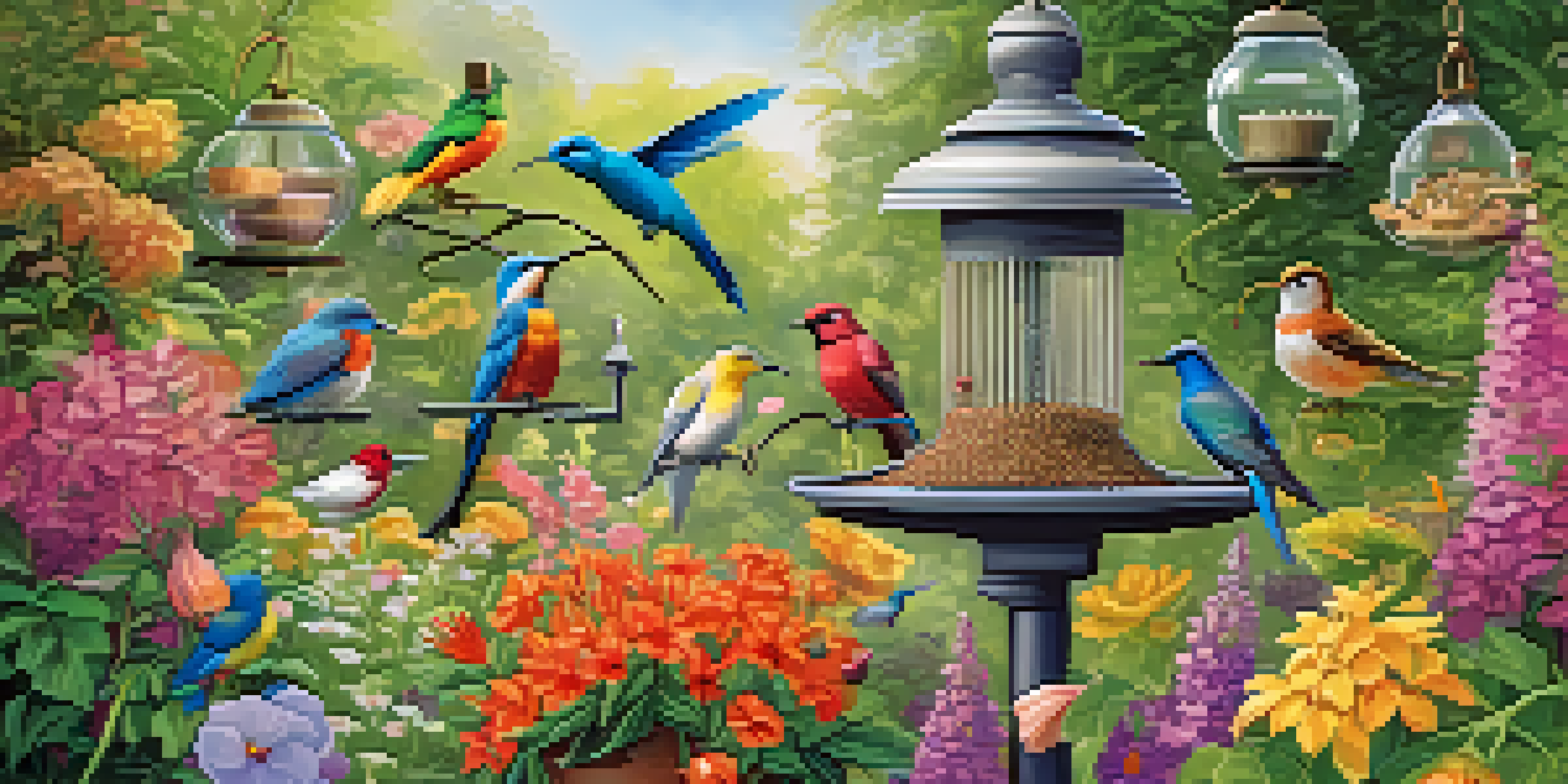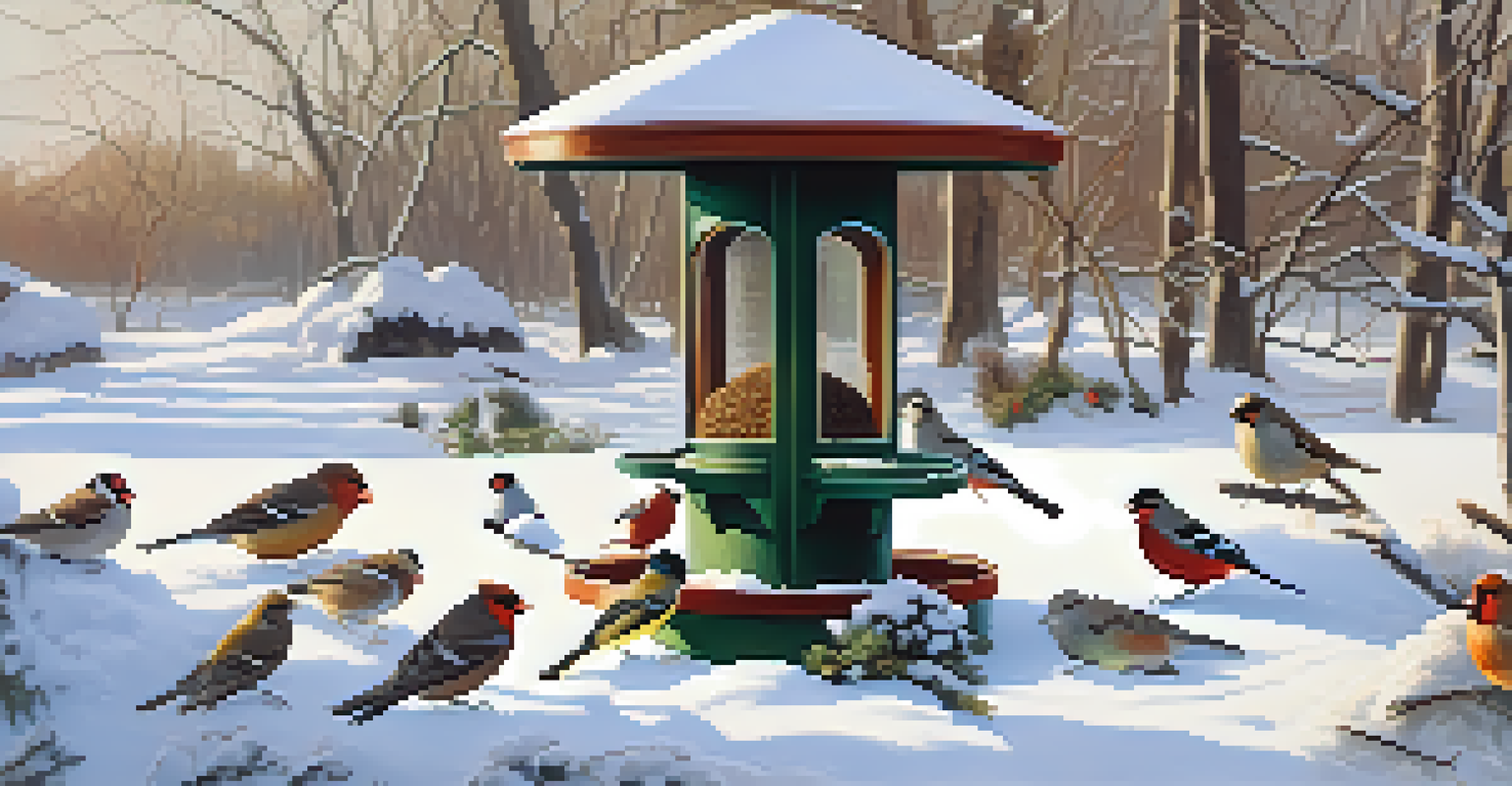Understanding Bird Behavior: Feeding Patterns and Habits

The Importance of Feeding for Birds' Survival
Feeding is crucial for birds' survival, as it directly impacts their health and ability to thrive. Birds require a balanced diet rich in nutrients to maintain energy levels, support feather growth, and fuel migration. Without adequate food, they may struggle to survive during harsh weather or breeding seasons.
To be able to watch birds is a great gift that nature has given us. It is a reminder of the beauty and wonder of the world we live in.
Different species have evolved unique feeding strategies to adapt to their environments. For instance, some birds, like hummingbirds, have specialized beaks to extract nectar from flowers, while others, such as woodpeckers, can forage for insects hidden in tree bark. This diversity in feeding habits showcases nature's ingenuity.
Understanding the feeding habits of birds can help us appreciate their role in the ecosystem. By pollinating plants and controlling insect populations, birds contribute to biodiversity and environmental health, making their feeding behaviors not just fascinating but vital for the planet.
Types of Bird Feeders and Their Impact on Feeding Habits
Bird feeders come in various shapes and sizes, each designed to cater to specific bird species and their feeding habits. For example, tube feeders are perfect for small birds like finches, while platform feeders attract larger species such as doves and jays. Choosing the right feeder can significantly enhance the bird-watching experience.

The type of food offered also influences which birds visit your garden. Seeds, suet, and nectar attract different species, so a diverse menu can bring in a wider variety of birds. Moreover, providing a consistent food source can encourage birds to return, allowing for more opportunities to observe their behavior.
Birds Need Diverse Diets to Thrive
A balanced diet rich in nutrients is essential for birds' health, energy, and survival.
It's important to keep feeders clean and well-stocked to prevent the spread of diseases among birds. Regular maintenance not only supports the health of visiting birds but also ensures that your feeding station remains an inviting spot for them to gather and feed.
Seasonal Changes in Bird Feeding Patterns
Bird feeding habits can change dramatically with the seasons. In spring and summer, many birds focus on feeding their young, which requires a high-protein diet, often consisting of insects. Conversely, during the fall and winter months, birds may switch to seeds and fruits as their primary food sources.
Birds are indicators of the health of the environment. If they are in trouble, we know we’ll soon be in trouble.
Migration also plays a critical role in how birds feed throughout the year. As some species migrate south for the winter, they must build up fat reserves during the autumn to sustain their long journeys. Understanding these patterns can help bird enthusiasts prepare their feeders accordingly, ensuring that they attract migratory visitors.
Additionally, local climate conditions can affect food availability. For instance, a harsh winter may drive birds to seek out feeders more frequently, while a mild fall might see them foraging naturally for longer. Observing these seasonal variations can deepen our appreciation of bird behavior and adaptability.
Social Dynamics of Feeding Among Birds
Birds are social creatures, and their feeding habits often reflect their social dynamics. Many species, such as sparrows and starlings, will feed in flocks, which can provide safety in numbers from predators. This communal feeding can also increase foraging efficiency, as birds can quickly locate food sources together.
However, competition for food can lead to aggressive behaviors, especially at feeders. Dominant species may chase away smaller birds, creating a hierarchy during feeding times. Observing these interactions can provide insights into the complex social structures within bird communities.
Seasonal Changes Affect Bird Feeding
Birds alter their feeding habits based on seasonal changes and food availability, adapting to their environment.
Interestingly, some birds have learned to coexist peacefully at feeders by taking turns or feeding at different times of the day. This adaptability showcases their intelligence and ability to navigate social challenges, further enriching our understanding of bird behavior.
The Role of Instinct in Bird Feeding Behavior
Instinct plays a significant role in how birds feed and what they choose to eat. Many species have innate preferences for certain types of food, which can be crucial for their survival. For instance, seed-eating birds are often drawn to specific seed types, while nectar-feeders instinctively seek out flowering plants.
Young birds learn feeding behaviors primarily from their parents. Through observation and mimicry, fledglings acquire the skills needed to find food in their environment. This learning process is vital for their survival, as they transition from dependence on their parents to independent foragers.
Moreover, environmental factors can influence these instincts. Changes in habitat, food availability, and competition can lead birds to adapt their feeding habits over time, showcasing their remarkable resilience and ability to thrive in varying conditions.
How Weather Influences Bird Feeding Behavior
Weather conditions can significantly impact bird feeding behavior. For example, during heavy rain or snow, birds often seek shelter and may rely more on feeders for sustenance. These adverse conditions can lead to an increase in feeder activity as birds look for reliable food sources.
Conversely, pleasant weather might encourage birds to explore natural food sources. With an abundance of insects and seeds available, they may spend less time at feeders. Understanding these patterns can help bird watchers anticipate when to expect increased activity at their feeding stations.
Conservation Supports Bird Feeding
Protecting habitats and creating bird-friendly spaces enhance food access, promoting healthy bird populations.
Additionally, extreme weather events, such as storms or droughts, can drastically alter food availability in the wild. These changes often force birds to adapt quickly, showcasing their resilience and adaptability in the face of environmental challenges.
Conservation and Its Impact on Bird Feeding Habits
Conservation efforts can have a significant impact on bird feeding habits and overall health. Protecting natural habitats ensures that birds have access to their preferred food sources, which is vital for their survival and reproduction. When ecosystems are preserved, birds can thrive and maintain their natural feeding behaviors.
Moreover, creating bird-friendly spaces in urban areas, such as parks and gardens, can help provide essential resources for feeding. Native plants attract insects and produce seeds, offering birds a natural buffet. By incorporating these elements into our landscapes, we can support local bird populations.

Public awareness and education about bird conservation can also encourage more people to provide feeding stations and support sustainable practices. Each small effort contributes to a larger movement aimed at preserving bird species and their feeding habits, ultimately benefiting our environment as a whole.